1. Purple Loosestrife
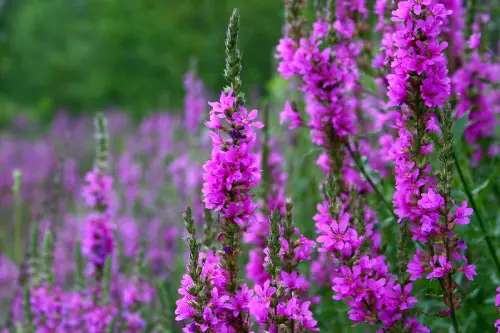
With its tall spikes of magenta flowers, purple loosestrife looks like a dream addition to any pollinator garden. But it’s actually one of the most invasive wetland plants in North America. It spreads rapidly by seed and underground rhizomes, forming dense mats that outcompete native plants. These monocultures reduce biodiversity and damage wetland ecosystems.
Each plant can produce hundreds of thousands of seeds per year, which are easily spread by water, wind, and wildlife. It’s been banned or restricted in many areas because of its impact. Even cultivars marketed as “sterile” have been found to hybridize and spread. What starts as a splash of color can quickly become an ecological disaster.
2. Trumpet Vine
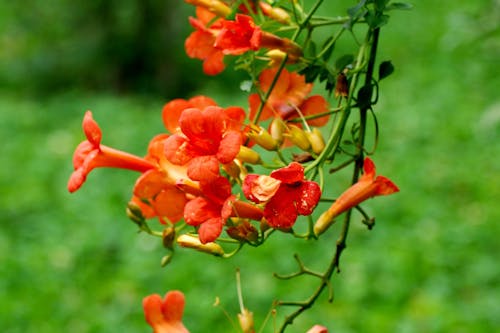
Trumpet vine is vibrant and loved by hummingbirds, but don’t let the showy orange flowers fool you. It’s one of those plants that seems manageable until one day you realize it’s everywhere. Its roots spread aggressively underground, popping up new shoots meters away from the original plant. It also climbs and clings to surfaces, quickly overtaking fences and trellises.
Its thick vines can pry into cracks and crevices, damaging structures over time. The plant is notoriously hard to remove once established, as even small root pieces can regenerate. It’s best suited for isolated spots with strong support and constant oversight. Without boundaries, it becomes a floral conqueror.
3. Mint
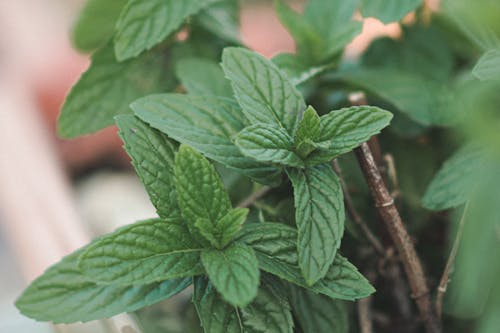
Mint might seem like a harmless little herb perfect for tea or garnishes, but once it takes root, it spreads like wildfire. It sends out underground runners that allow it to pop up feet away from where you planted it. Even if you try to pull it up, any leftover roots can start the whole cycle again. Many gardeners end up containing it in pots just to keep it from taking over.
It doesn’t need much encouragement—mint thrives in both sun and partial shade and can tolerate poor soil. That means it’s not only persistent but also highly adaptable. Its vigorous growth can easily crowd out other, more delicate herbs and flowers. It’s the kind of plant that smiles sweetly while secretly scheming to rule your garden beds.
4. Bamboo
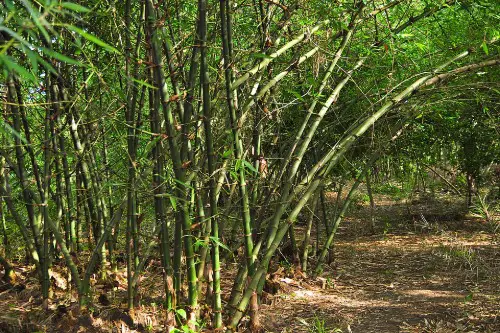
Bamboo looks like a peaceful addition to any Zen garden, but it’s a fast-growing powerhouse that can become a nightmare. Some species, especially running bamboo, can grow several feet in just a few days. It spreads through underground rhizomes, which makes it extremely difficult to contain. Before you know it, your entire yard—and maybe your neighbor’s too—can be filled with towering stalks.
Its root system is strong enough to crack pavement and invade foundations. Even cutting it back doesn’t work long-term unless you install deep root barriers. Bamboo may be beautiful and provide quick privacy, but it demands serious maintenance and control. Once it’s out of the bag, it’s nearly impossible to get it back in.
5. Wisteria
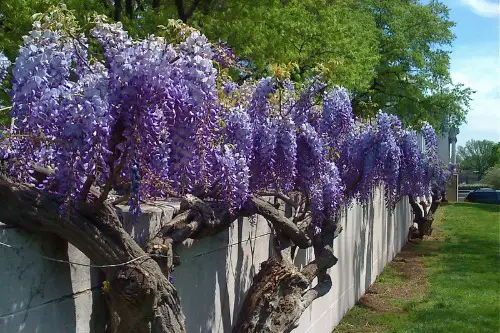
With its romantic drapes of purple flowers, wisteria seems like the plant version of a love poem. But give it a few seasons and you’ll realize it has a dark side. Wisteria is a climbing vine that can choke out trees, smother buildings, and pull down trellises with its weight. It’s aggressive, woody, and tough as nails once established.
It grows quickly and twines around anything it can reach, often girdling and damaging its support structure. You’ll need to prune it often and carefully, or it’ll take over your yard in no time. Left unchecked, it becomes more beast than beauty. It’s best for gardeners with time and tools to stay ahead of it.
6. English Ivy
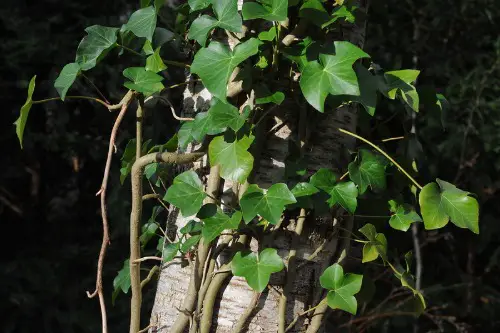
English ivy gives off classy, old-English estate vibes, but it’s one of the most invasive plants around. Once it takes hold, it climbs walls, fences, and trees—and it doesn’t stop. It can smother tree trunks and weaken them by blocking sunlight and adding weight. In many regions, it’s considered an ecological threat due to how it chokes out native species.
Its aerial rootlets allow it to cling tightly to surfaces, making it difficult to remove once established. Cutting it back doesn’t kill the root system, so it often comes roaring back. Even worse, it can damage brick and wood as it clings and creeps. What looks like elegance can turn into an expensive landscaping headache.
7. Morning Glory
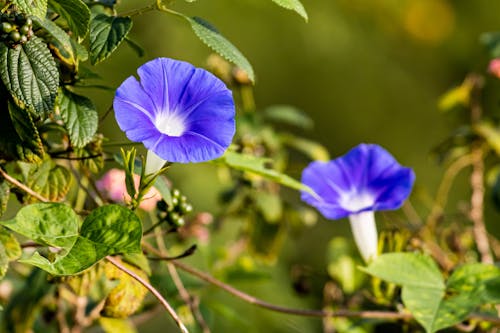
Morning glories look delicate with their heart-shaped leaves and cheerful blooms that open with the sunrise. But give them a warm season and they’ll sprawl over everything. They reseed prolifically and can pop up all over your garden year after year. Their vines grow fast and can strangle smaller plants as they climb.
If left alone, morning glories can form thick tangles that are hard to manage. The seeds are also extremely persistent and can remain viable in the soil for years. Though they’re annuals in many climates, their invasiveness rivals that of perennials. They’re charming, but they don’t know when to quit.
8. Japanese Knotweed
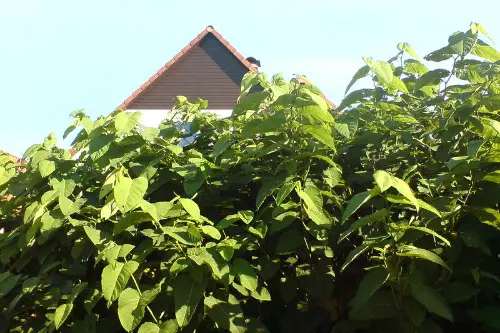
Japanese knotweed starts off looking like a harmless stand of tall bamboo-like stalks, but it’s a structural menace. It can break through concrete, asphalt, and even the foundations of buildings. It spreads aggressively through rhizomes, and even the smallest root fragment can spawn a new plant. It’s listed as a noxious weed in many countries due to the damage it causes.
Once established, it’s nearly impossible to eliminate without repeated herbicide use or excavation. Its growth habit allows it to form dense stands that block out everything else. Despite its innocent spring appearance, it’s one of the most destructive plants you can accidentally welcome into your yard. Avoid it at all costs if you value your lawn—and your home.
9. Creeping Jenny
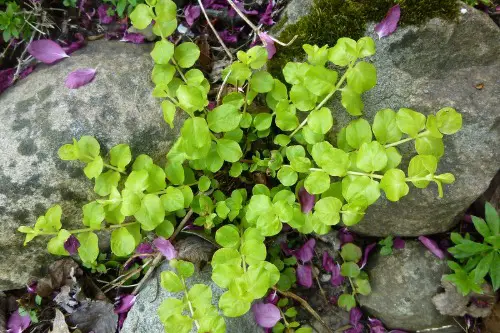
Creeping Jenny has a sweet name and a soft look, but it creeps a little too well. It forms a dense mat that can quickly smother nearby plants. It roots at the nodes as it spreads, making it difficult to pull out completely. While it works well in containers or as ground cover, it’s relentless in open garden beds.
It thrives in moist areas and spreads fast if left unchecked. Even in less ideal conditions, it can still expand at a steady pace. Once it gets into your lawn or flower beds, you’ll be chasing it for seasons. It’s low-growing, but it doesn’t know when to stop.
10. Sweet Autumn Clematis
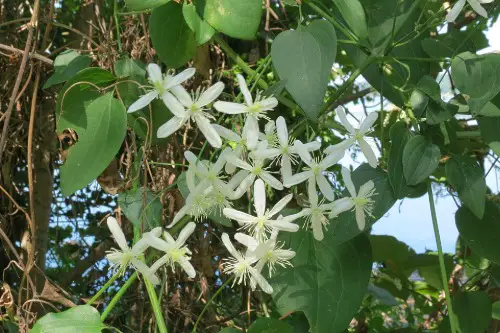
With its fragrant white blooms and cascading vines, sweet autumn clematis seems like a gentle garden companion. But once it starts to grow, it does so with surprising force. It self-seeds heavily and climbs rapidly, covering fences, trees, and anything else in its path. While beautiful, it can overwhelm native plants and garden structures alike.
Because it blooms later in the season, many gardeners don’t notice its true strength until it’s too late. The vines can reach 20 to 30 feet in a single season under the right conditions. It’s not the worst offender on this list, but it’s sneaky in how quickly it establishes. Without regular pruning, it becomes more invader than ornament.
11. Lamb’s Ear
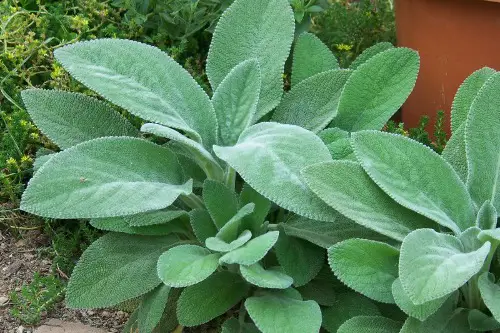
Soft, fuzzy, and adorable—lamb’s ear is the teddy bear of garden plants. But don’t be fooled by those velvety leaves. It spreads by both seed and creeping roots, often forming thick colonies that push out other ground-level plants. In optimal conditions, it can take over a flower bed surprisingly fast.
Its dense growth also makes it hard for smaller or slower-growing plants to compete. While it can be controlled with some effort, many gardeners don’t realize how quickly it expands. It’s best used in contained borders or rock gardens where it can’t run wild. Think of it as a cuddly guest who slowly moves in and takes over your couch.
12. Bugleweed (Ajuga)
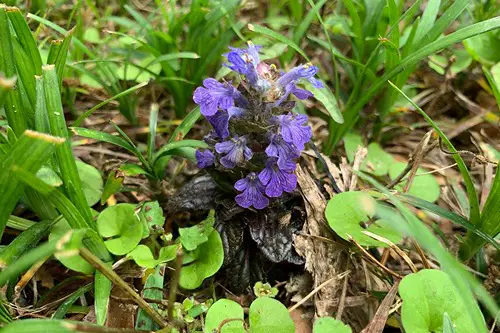
Bugleweed is often planted for its attractive purple-blue flower spikes and dense, glossy foliage. It hugs the ground tightly and looks like the perfect filler for bare patches in garden beds. But once it settles in, it spreads rapidly through stolons—horizontal stems that root wherever they touch soil. Within a single season, it can form a thick carpet that’s nearly impossible to remove.
Its aggressive nature chokes out more delicate plants, especially in shaded or moist areas where it thrives. Trying to dig it out often results in pieces breaking off and regenerating elsewhere. It’s best used in confined areas where it can’t sneak into your lawn or flower beds. Left unchecked, it’ll quietly blanket your entire yard in a matter of seasons.
13. Periwinkle (Vinca Minor)
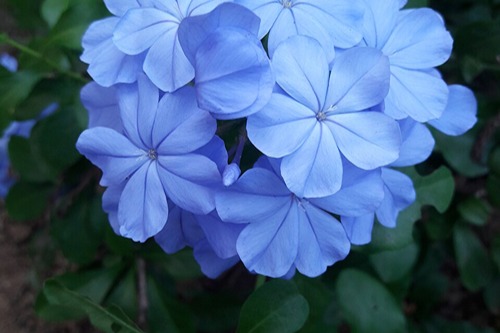
Periwinkle’s glossy leaves and perky blue-violet flowers give it an innocent charm, making it a popular choice for ground cover. But this plant spreads aggressively, especially in shady spaces, where it forms dense mats that outcompete native plants. Its trailing stems root easily as they spread, making it hard to contain once established. What starts as a small patch can double or triple in size within a single growing season.
Invasive in many regions, periwinkle is especially problematic in forested or naturalized areas. It prevents other plants from establishing and creates a monoculture that reduces biodiversity. Though it’s low-maintenance, it’s also high-impact in all the wrong ways. If you’re going to plant it, be prepared to play defense constantly.
14. Obedient Plant
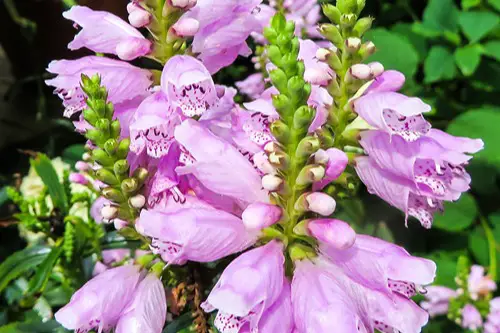
The name “obedient plant” is either ironic or wishful thinking, because it does anything but behave. Its snapdragon-like blooms are gorgeous and make it seem like a dream perennial for pollinator gardens. But it spreads aggressively through rhizomes and self-seeds freely, creating a rapidly expanding patch that can edge out neighbors. Once rooted, it doesn’t respond well to relocation—making it disobedient both in growth and management.
In ideal conditions, the obedient plant will colonize entire beds in just a couple seasons. Its upright stems form dense clusters that are difficult to remove once they’ve taken hold. Despite its attractive flowers, it’s considered invasive in many areas. Plant it only if you’re willing to keep it on a very short leash.
15. Horseherb (Calyptocarpus vialis)
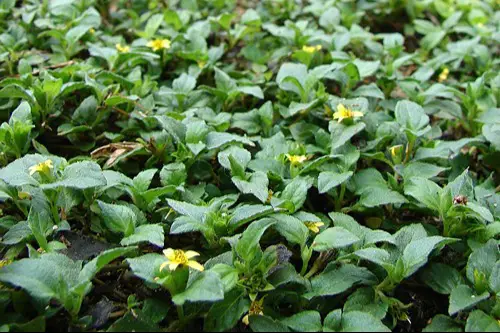
Horseherb is a native ground cover in parts of the southern U.S., often praised for its drought tolerance and soft green look. It even blooms with small yellow flowers that look cute at first glance. But once it gets comfortable, it becomes a prolific spreader in lawns and flower beds alike. It roots wherever its stems touch soil and shrugs off mowing like it’s a spa treatment.
Many homeowners find it popping up uninvited in shady lawns, quickly overtaking turfgrass and other ground covers. It’s difficult to control once established, especially in warm, humid climates. Though native, it behaves like an invasive in manicured yards. It’s the unassuming green blanket that refuses to stay where you put it.
16. Gooseneck Loosestrife
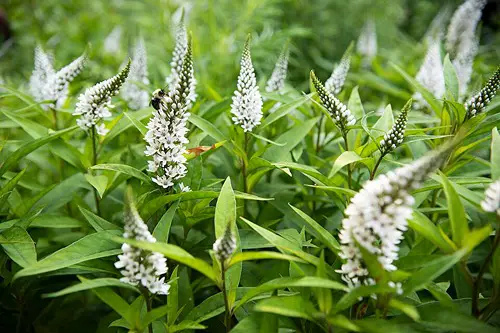
Gooseneck loosestrife gets its name from its charming flower spikes that curve like a goose’s neck. It adds a whimsical, cottage-garden vibe when first planted. But underground, it spreads via a network of rhizomes that quickly claim nearby soil. Before long, your garden is less curated and more colonized.
It’s one of those plants that doesn’t play nicely with others, often forming dense patches that push out anything less aggressive. Even frequent dividing and cutting won’t stop its underground march. It’s best planted in large containers or isolated garden beds with deep barriers. Otherwise, expect your flower beds to be all goose, all the time.
17. Plume Poppy (Macleaya cordata)
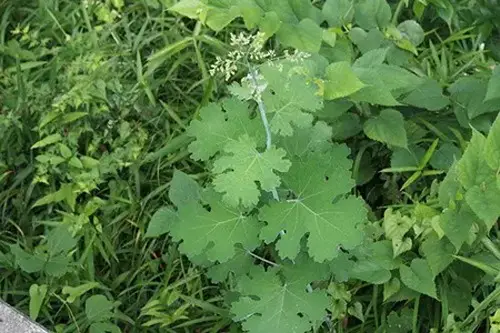
With its large, scalloped leaves and tall plumes of airy flowers, plume poppy has a dramatic, almost architectural presence. It looks like a designer plant—until it escapes its bounds. It spreads aggressively by underground rhizomes, often traveling far beyond where you intended. Worse, it grows tall quickly, shading out smaller plants before you realize what’s happening.
Removing it is a challenge since even small root pieces regenerate. In many cases, gardeners report it coming back years after removal efforts. While undeniably beautiful, it’s not a plant for casual or small-space gardening. Without containment, it becomes a garden bully in no time.
18. Virginia Creeper
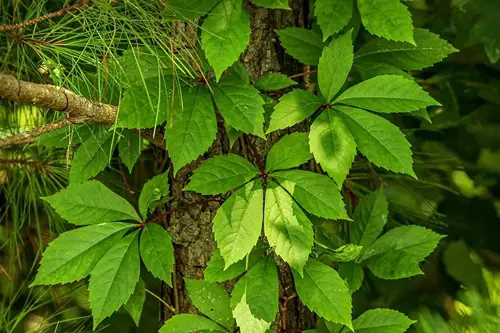
Virginia creeper is often mistaken for poison ivy, but it’s actually a native vine with stunning red fall foliage and fast-growing stems. It clings to fences, walls, and trees with sticky tendrils and can climb several feet in a single season. Though it offers some wildlife value, it’s not shy about taking over. It can smother other plants and damage surfaces it clings to.
Even worse, its rapid growth means you might not even realize how much ground it’s covered until it’s too late. It’s nearly impossible to fully remove once established, as it regrows from root fragments. While attractive in the right spot, it requires strict boundaries and regular trimming. Without them, it becomes the uninvited guest that takes over the whole party.
19. Chameleon Plant (Houttuynia cordata)

Chameleon plant is colorful and exotic-looking, with variegated leaves splashed in red, yellow, and green. But beneath the surface, it’s hiding one of the most aggressive root systems around. It spreads via rhizomes that grow deep and wide, sending up new shoots even after heavy pruning or digging. Left alone, it can quickly dominate a yard and even cross into neighboring properties.
Controlling it often requires landscape fabric, deep barriers, or complete soil removal. Even chemical treatments struggle to stop it. What starts as a pretty accent in a shady corner can turn into a lifelong landscaping battle. Its beauty fades fast once you realize how hard it is to evict.
This post 19 Plants That Look Friendly But Dominate the Entire Yard was first published on Greenhouse Black.
